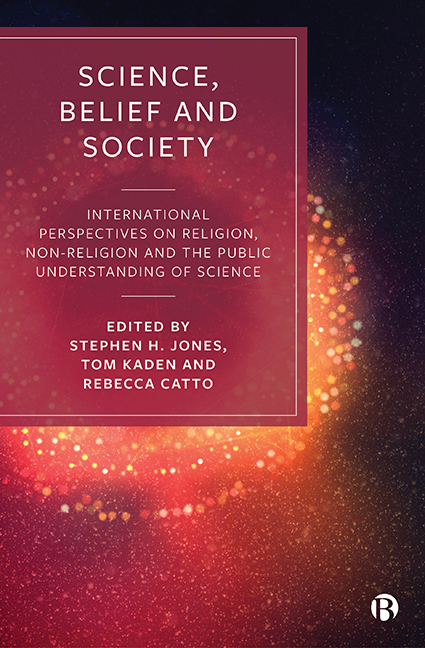 Science, Belief and Society
Science, Belief and Society Book contents
- Frontmatter
- Contents
- List of Figures and Tables
- Notes on Contributors
- Editors’ Acknowledgement
- Foreword
- Editors’ Introduction: Science, Belief and the Sociological Tradition
- PART I Methodological Challenges in the Study of Science and Belief
- PART II Belief in the Study of Science and Technology
- PART III Science, Culture and Non-religion
- PART IV Religion, Conflict and Moderation
- Conclusion: Future Directions in the Sociological Study of Science and Belief
- Index
1 - The Sociological Study of Science and Religion in Context
Published online by Cambridge University Press: 27 April 2022
- Frontmatter
- Contents
- List of Figures and Tables
- Notes on Contributors
- Editors’ Acknowledgement
- Foreword
- Editors’ Introduction: Science, Belief and the Sociological Tradition
- PART I Methodological Challenges in the Study of Science and Belief
- PART II Belief in the Study of Science and Technology
- PART III Science, Culture and Non-religion
- PART IV Religion, Conflict and Moderation
- Conclusion: Future Directions in the Sociological Study of Science and Belief
- Index
Summary
Science and religion: a disciplinary blind spot?
The growing interest in the social study of science and religion, to which this volume speaks, is opening up new avenues of qualitative study in an area where there has been a surprising paucity of such research. The chapters in this collection bring together for the first time a range of empirical sites, focusing attention on a variety of religious and non-religious interactions with, and uses of, science. This relative lack of social research on ‘science and religion’ is surprising given the comparative wealth of research conducted in a variety of disciplines concerning ‘religion’ and ‘science’ as separate social and cultural phenomena. This lacuna has led to some issues and problematic assumptions, especially in the way that social-scientific research regarding the relationship between science and religion has framed this relationship (Elsdon-Baker, 2015, 2018). Given the relatively recent emergence of this mode and subject of research, it is both important and timely to engage with the theoretical and methodological backdrop to this growing area of study.
One of the rather unique and exciting facets of this field is that, by its very nature, it draws on expertise and research traditions that do not always ordinarily intersect in the academy. This not only means – as the editors observe in the Introduction to this volume – intellectual traditions within sociology, such as the sociology of religion and the sociology of science and technology, but also those beyond it, such as the history and philosophy of science. This presents some problems that, in part, relate to any multidisciplinary research – significantly, the need to be aware of the norms, traditions, language use and pitfalls to be avoided within each discipline or sub-discipline involved in the research. However, there are also some challenges that are specific to the study of science and religion in society; in this case, the intersection is between two subjects of research that are often perceived to be incommensurable, or, at worst, seen to be in direct and destructive opposition to one another. Thus, any researcher starting out their voyage into what have hitherto been the uncharted waters of the social study of science and religion in society needs to be aware of some of the underlying assumptions that may turn what appears to be plain sailing into a perfect storm of both academic and public criticism.
- Type
- Chapter
- Information
- Science, Belief and SocietyInternational Perspectives on Religion, Non-Religion and the Public Understanding of Science, pp. 3 - 24Publisher: Bristol University PressPrint publication year: 2019
